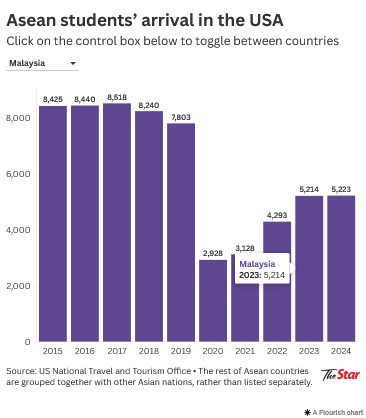June 17, 2025
PETALING JAYA – Malaysian student arrivals to the United States of America have fallen this year amid uncertainties over US foreign student policies.
According to figures from the US National Travel and Tourism Office website, the number of Malaysians arriving in the United States on student visas from January to April this year dropped by 7% to 1,754 compared to 1,887 in the same period last year.
Education consultants said the uncertainties, added with rising costs due to a stronger US dollar as well as shifting preferences, are contributing to the decline.
They say that these factors have led some students to consider alternative countries, or study programmes that offer shorter stints in the US.
Malaysia’s 7% drop is the largest among Asean countries.
Thailand had the second biggest decline at -3.1%, followed by Indonesia at -2.3%.

The rest of ASEAN countries are grouped together with other Asian nations, rather than listed separately. SOURCE: US NATIONAL TRAVEL AND TOURISM OFFICE/GRAPHICS: THE STAR
All Asean countries recorded a drop in student arrivals to the United States from January to April this this year, except for Vietnam, which saw a 21% increase.
Vietnam sent 25,206 students to the United States last year, the biggest number among Asean countries.
Singapore was second (9,639) followed by Thailand (7,081).
Policy changes introduced by the Trump administration have led to reports of some Malaysian students reconsidering their plans to pursue higher education in the United States.
Their concerns were heightened following reports that US Secretary of State Marco Rubio had instructed US embassies to halt the scheduling of student visa interviews as the administration moves to expand social media screening for applicants.
On June 6, the US State Department reportedly instructed consulates worldwide to resume processing visa applications for international students admitted to Harvard University, reversing earlier guidance to reject such requests.
The figures from the US National Travel and Tourism Office, which go back to 2015, show that about 8,000 Malaysians arrive in the US on student visas each year.
The Covid-19 pandemic led to a drop to below 3,000 in 2020.
The figures have been increasing each year since but have still not fully recovered to pre-pandemic levels, with 5,223 Malaysian student arrivals recorded last year.

SOURCE: US NATIONAL TRAVEL AND TOURISM OFFICE/GRAPHICS: THE STAR
When contacted, the US Embassy in Kuala Lumpur said it had no further remarks to add to earlier comments it had issued to The Star.
On June 3, The Star reported that the embassy had assured Malaysian students that applications for study in the US remain open as usual, with no cancellations to previously scheduled visa appointments.
Higher education consultant Joey Ban said political developments in the US, particularly under the Trump administration, had contributed to the decline.
“When Trump took office in 2017, he implemented policies that were seen as rather unfriendly to international students,” said Ban, Principal Consultant at Edu Experts.
“The international student community anticipated similar or stricter policies this time around and shifted their focus to other destinations.”
She said the cost of higher education in the United States is a deterrent due to the strengthening US dollar.
“Few families have the financial capacity to support their children through a four-year bachelor’s degree in the US.
“The duration to obtain a similar degree in the UK or Australia is also shorter.
“As Malaysians, we are not short of choices. We now have quality options in Malaysia at a much lower cost. Interest is also gaining to study in China and South Korea,” she said.
Ng Yih Chen, president of the American Universities Alumni of Malaysia, said the drop in numbers is part of a long-term trend dating back to the Asian financial crisis in 1997.
“In the 1980s, there were over 10,000 Malaysian students in the US, but since the mid-80s, even state-owned universities, which are more affordable, raised their tuition fees which have now doubled,” he said.
Ng said negative portrayals of the United States on social media have further discouraged parents from sending their children there.
“Microscoping only the negativity, without sharing the positive aspects, has had an impact,” he said.
Ng added that continued uncertainty around US immigration and education policy had prompted many students to adopt a “wait-and-see” approach.
Doreen John, Head of Partnerships and Student Engagement at Sunway University’s School of American Education, said fluctuations in enrolment are normal and often influenced by currency exchange rates, safety concerns and policy changes.
“From early through mid-2024, when students were planning where to study and sending in applications, the US dollar rose to 4.70 and above against the Ringgit,” she said.
She said increased competition from other countries and enhanced local education offerings have also shifted student preferences.
“Other destinations are improving program quality, stepping up marketing and introducing post-study work opportunities.
“For many families, the cost of studying and living overseas is excessive. Local options are now more viable and attractive,” she said.
Doreen said Sunway University also offers more affordable options through its American Degree Transfer Program, with students being offered to earn an Arizona State University degree entirely in Malaysia.
“Year 1 subjects will begin in 2025, followed by the remaining years locally or via transfer,” she said.
Doreen said despite the decline, US universities’ appeal remains.
“The universities still welcome international students and have excellent systems, services and facilities to help them thrive.
“At this particular time, some government policies seem unwelcoming, but the universities themselves do not implement those policies,” she said.
She said safety issues, such as natural disasters or aviation accidents, may have also led families to prefer destinations closer to home.
“For some, this may have the effect of staying put or being closer to one’s home country,” she said.

